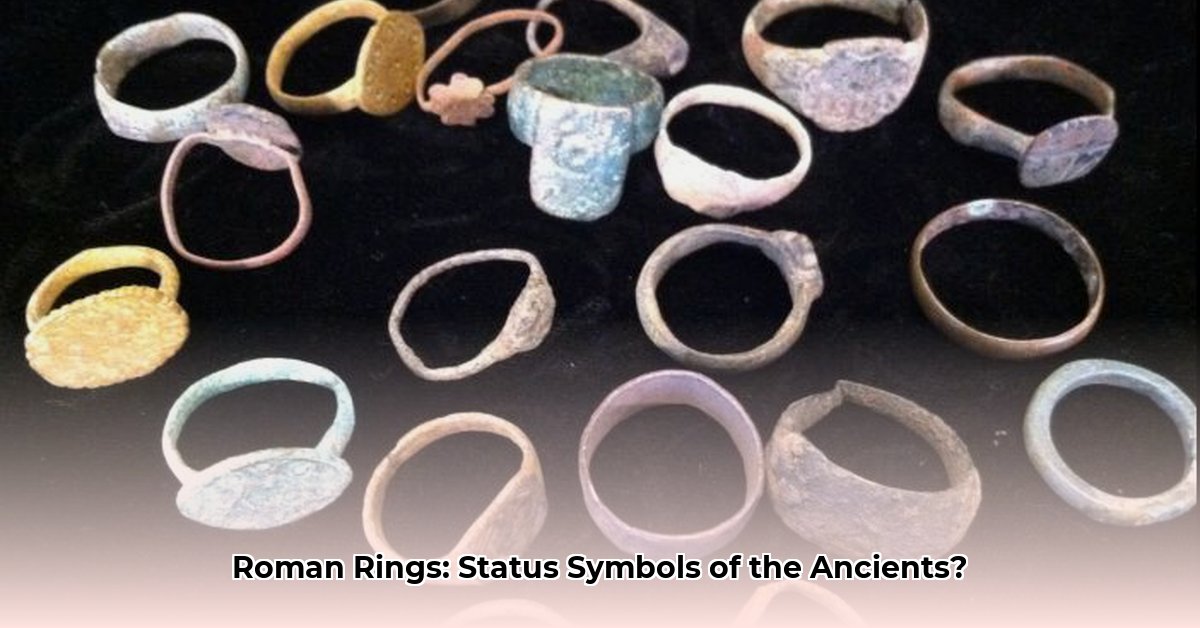Have you ever considered how a seemingly simple piece of jewelry could convey a person’s entire identity, social standing, and deepest beliefs? In ancient Rome, rings were far more than mere embellishments; they were potent symbols, wearable narratives announcing wealth, power, love, and even protection. Discover more about these Roman adornments that tell a story of the past. Join us on a captivating journey into the world of ancient Roman rings, exploring the intricate craftsmanship, diverse materials, profound symbolism, and the enduring influence these remarkable artifacts continue to exert on contemporary jewelry design. Prepare to uncover the layered stories hidden within these small, circular treasures of metal and stone.
Masterful Craftsmanship and Diverse Materials
The essence of an ancient Roman ring lay in the skillful artistry of its creators and the rich palette of materials at their disposal. While earlier Greek traditions often prioritized intricate metalwork, Roman jewelers increasingly shifted their focus towards the vibrant allure of colored gemstones and glass. Wealthy Romans conspicuously displayed rings crafted from gold and silver, unmistakable indicators of their elite status. In contrast, individuals lower on the social hierarchy typically wore rings made of bronze or iron, vividly illustrating the rigid social stratification prevalent in Roman society.
Roman artisans were celebrated for their ingenuity, pioneering advanced metalworking techniques such as casting, molding, filigree, granulation, and enameling. These methods facilitated the efficient mass production of rings, making such accessories more widely accessible. Yet, the most exquisite and labor-intensive pieces, often featuring sophisticated bezel settings to secure precious stones, remained exclusively within the grasp of the wealthiest citizens.
The Romans’ vast trade networks provided access to an astonishing array of precious and semi-precious gemstones. Garnet, emerald, amethyst, and lapis lazuli were imported from regions like Egypt, while onyx, amber, and moonstone traveled from the Persian Gulf. Glassmakers were so adept that their creations often mimicked genuine gems, a testament to Roman innovation and the high value placed on visual impact over intrinsic material value. For those who could afford authentic gems, pearls were particularly prized, sometimes fashioned into elaborate earring clusters known as crotalia.
Rings as Emblems of Roman Society and Status
In the intricate tapestry of ancient Roman society, Roman rings transcended mere decoration to become powerful signifiers of identity, authority, and social standing. Wearing a gold ring almost invariably denoted membership in the elite, while the humble iron ring was typically a mark of the plebeian class. However, the Roman social hierarchy was not entirely immutable. Exceptional acts of bravery or significant civic contributions could earn an individual the coveted privilege of donning a gold ring, subtly blurring the strict boundaries between social strata and demonstrating avenues for personal advancement.
Roman society even enacted sumptuary laws, regulations designed to control who could wear specific types of adornment. These laws aimed to preserve the existing social order and prevent individuals from lower classes from outwardly appearing wealthier than their actual status. Historical sources, such as the writings of Pliny the Elder, indicate the profound importance of these adornments. Despite these laws, some historical accounts suggest that individuals from the plebeian classes occasionally plated their iron rings with gold, underscoring the universal aspiration to ascend the social ladder and the inherent challenges in enforcing such strict social boundaries. Senators, for instance, wore distinctive gold rings often featuring large, flashy gemstones to unequivocally signal their high rank. Military allegiance was also expressed through rings bearing legionary eagles, chevrons, and naval patterns.
The Enduring Romance: Roman Engagement and Wedding Rings
Beyond their role in defining status, rings held profound personal significance in ancient Roman traditions, especially concerning love and commitment. The exchange of an engagement ring symbolized a formal contract, not only between the couple but also between their respective families. It marked a woman’s transition from her father’s authority to her future husband’s household. Early Roman wedding rings were frequently crafted from iron, a material chosen for its symbolism of strength, permanence, and the durability of the marital bond. Over time, gold became the preferred material, signifying wealth, prosperity, and the strengthening of the couple’s union.
Perhaps the most iconic type of Roman marriage ring was the fede ring, characterized by a distinctive design featuring two clasped hands, representing unity, fidelity, and the aspiration for a prosperous future together. The Romans also embraced a charming belief that a special nerve, the vena amoris (vein of love), connected the fourth finger of the left hand directly to the heart. This ancient anatomical theory is the very reason why many cultures today continue to wear engagement rings and wedding bands on that particular finger, a lasting testament to Roman romantic sentiment. Furthermore, the Romans were pioneers in personalizing these symbols of affection, often engraving poignant messages. A famous example is a fede ring in the British Museum bearing the Latin inscription “Te amo parum,” or “I love you too little,” which has been sweetly interpreted as the giver’s humble acknowledgement that no amount of love could truly match their beloved’s worth.
Spiritual Significance: Roman Rings as Amulets and Offerings
Beyond their aesthetic and social functions, ancient Roman rings frequently served as protective charms or amulets. Children, particularly young boys from elite families, commonly wore bullae – small, protective golden amulets often accompanied by rings, intended to ward off evil forces and misfortune. These devices sometimes incorporated specific symbols, such as the phallic fascinus, believed to possess potent apotropaic powers.
Rings also played a significant role in Roman religious life. Archaeological discoveries at Greek and Roman temples have unearthed hoards of gold, silver, and bronze jewelry, providing compelling evidence that worshippers would offer their rings to gods and goddesses as tokens of devotion, gratitude, or requests for divine favor. Rings were even integrated into funerary practices, particularly after the sack of wealthy Greek cities like Tarentum. It became increasingly popular for Romans to use delicate gold wreaths or diadems in burials for both men and women, further underscoring the deep integration of rings and other jewelry into the spiritual and cultural fabric of ancient Rome.
Signet Rings: The Power of Personal Seals
A distinct and highly functional category of Roman rings was the signet ring. These powerful artifacts were far more than mere jewelry; they served as essential personal seals for authentication and identification. Adorned with intricate designs, family crests, initials, or professional emblems, a signet ring was a direct reflection of an individual’s social status, authority, and influence.
Signet rings, predominantly crafted from gold or silver, were used to create unique impressions or wax seals on official documents, contracts, and letters. This practice ensured the authenticity of communications and prevented forgery, making signet rings indispensable tools in Roman legal and political life. As Suetonius, the Roman historian, noted, these rings were direct symbols of power and authority, worn by emperors, senators, and high-ranking officials to assert their dominance and strengthen social bonds. The meticulous craftsmanship involved in carving these unique seals further cemented their value and significance.
The Timeless Allure: Roman Rings in Modern Design
Even millennia later, the profound influence of Roman jewelry design remains undeniably vibrant. Contemporary jewelry designers frequently draw inspiration from ancient Roman motifs, skillfully reinterpreting classic elements like snake bracelets, fede rings, and intricate cameos. They masterfully blend these classical ideas with modern techniques and materials to create unique and captivating pieces that resonate with historical depth.
The enduring legacy of these ancient adornments is evident in current trends. The resurgence of signet rings is a prime example, evolving from symbols of authority to fashionable accessories that allow individuals to express personal statements. Modern craftspeople, much like their Roman predecessors, are even exploring new materials, incorporating alternative choices like art glass into their designs, mirroring the Roman emphasis on visual splendor.
Furthermore, there’s a growing inclination towards sustainable practices in contemporary jewelry. Modern designers are increasingly utilizing recycled materials to minimize environmental impact, echoing the Romans’ practical approach to resourcefulness. This fusion of historical inspiration with modern ethical values creates pieces that not only honor the past but also embrace a more responsible future. The remarkable journey of rings, from their ancient Roman origins as markers of legal contracts and social standing to declarations of unique, ethically-minded love, continues to captivate and inspire.
Beyond Design: Preserving and Collecting Ancient Roman Rings
For enthusiasts and collectors, ancient Roman rings hold immense historical and cultural significance, making their preservation paramount. Proper care and handling are crucial to ensuring the longevity of these precious artifacts. When storing, maintain a cool, dry environment away from direct sunlight and extreme temperature fluctuations, ideally in acid-free archival boxes. Cleaning should be gentle, using only a soft, lint-free cloth or a mild soap solution, avoiding harsh chemicals that could damage delicate materials or the valuable patina.
For those venturing into collecting, thorough research is key. Familiarize yourself with different styles, materials, and historical contexts. Always consult reputable dealers, auction houses, or certified appraisers for authentication, requesting provenance documentation whenever possible. While some wear and patina are natural, assessing the condition for excessive damage or restoration is important for both historical integrity and value. Diversifying a collection by acquiring rings from various periods and regions can offer a richer understanding of Roman craftsmanship and cultural nuances.
Famous Ancient Roman Rings: Tales of Treasure
Throughout history, a few ancient Roman rings have garnered particular renown, not only for their exquisite craftsmanship but also for the intriguing stories they tell.
- The Ring of Senicianus: Dating back to the 4th century AD, this gold ring is infamous for a curse inscribed on its surface: “May Senicianus live in suffering,” believed to be a response to the ring’s alleged theft. It offers a fascinating glimpse into Roman superstitions.
- The Gemma Augustea: While primarily a cameo, this masterpiece often set into a ring or pendant, crafted during Emperor Augustus’s reign, showcases two layers of sardonyx depicting mythological scenes and imperial portraits. It exemplifies the pinnacle of Roman imperial artistry and propaganda.
- The Ring of Gaius Marius: Believed to have belonged to the celebrated Roman general, this gold signet ring features an engraved image of a warrior, symbolizing military prowess, courage, and the achievements of one of Rome’s most influential figures.
These legendary pieces not only reflect the artistic skills of ancient Roman jewelers but also provide invaluable insights into the traditions, beliefs, and triumphs of their era.
Conclusion
Ancient Roman rings stand as invaluable relics, offering a profound glimpse into the rich tapestry of Roman civilization. These intricate pieces of craftsmanship beautifully showcase the ingenuity and artistry of Roman artisans, as well as the immense cultural significance placed upon jewelry in this ancient society. From the careful selection of materials like gold, silver, and diverse gemstones, to the sophisticated evolution of designs and the layered symbolism embedded within each ring, these artifacts narrate stories waiting to be fully appreciated. Whether denoting social status, symbolizing love and commitment in marriage, or serving as protective amulets and personal seals, Roman rings were integral to daily life.
The enduring influence of Roman jewelry design is undeniable, continuing to inspire contemporary creators and trends. From faithful reproductions to innovative interpretations, the aesthetic elements, ornate patterns, and symbolic motifs of Roman rings have transcended millennia. As these precious artifacts continue to be discovered, studied, and collected, it is crucial to ensure their meticulous preservation. With proper care and appreciation, future generations can continue to marvel at the timeless allure and profound significance of ancient Roman rings, reminding us of the extraordinary legacy left behind by this remarkable civilization.
| Feature | Ancient Roman Rings | Modern Rings Inspired by Roman Designs |
|---|---|---|
| Materials | Gold, silver, bronze, iron, diverse natural gemstones (garnet, amethyst, lapis), glass | Precious metals (recycled often), lab-created gems, alternative materials (glass, resin) |
| Motifs | Snakes, clasped hands (fede), mythological figures, imperial symbols, cameos, specific animals | Reinterpretations of Roman motifs, minimalist adaptations, fusion with contemporary aesthetics |
| Manufacturing | Casting, molding, intricate gem-cutting, engraving, filigree, granulation, enameling, bezel settings | Modern fabrication, 3D printing, combined with traditional hand-finishing |
| Symbolism | Status, wealth, love, commitment, protection, authority, identity, legal contract | Aesthetic appeal, historical connection, personal style, ethical values, self-expression |
| Social Context | Integral part of social hierarchy, religious practices, legal system, daily life | Fashion accessory, symbolic representation (e.g., wedding rings), personal adornment |










